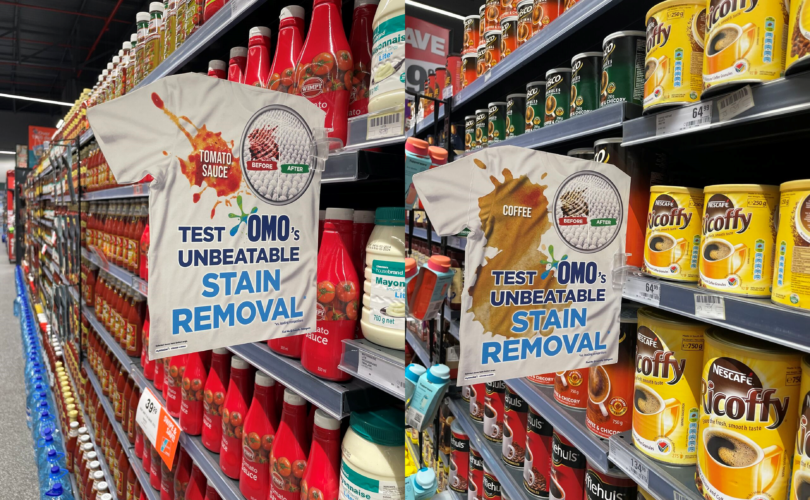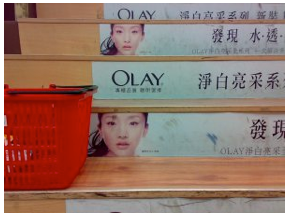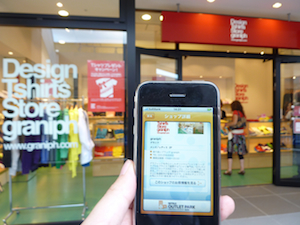Getting promotional material about your brand located in a different category in a store is, for many shopper marketers, a highly sought-after prize. It is also notoriously difficult to achieve. So, when The Institute of Promotional Marketing posted this example of cross-category in-store signage, it attracted a lot of attention and a lot of well-deserved praise. But is it that good? More importantly, is it going to be effective? In this post I’m going to use this example from OMO to deep-dive into the science and thinking around secondary communication and share the critical success factors of this type of activity.
OMO – A great cross-category in-store signage idea
So let’s take a look at this interesting activity from OMO. The idea is simple, and most of us applaud the idea. Omo gets rid of stains. Stains are caused by substances such as ketchup and coffee (and indeed these are often featured in advertising campaigns), so there is a natural association, right? The location makes sense because coffee causes stains and OMO gets rid of them, right?
The rest of this article might come across as a little negative. That isn’t the intention. The idea is great. The thinking is great. And for all I know it might work brilliantly. But it struck me as a super opportunity to learn. So kudos to the OMO shopper marketing team if you are reading this – kudos for trying something different, and I really hope you are proud of the results you get!
I’d love to see the results of this – in theory its terrific – but in practice, I’m less sure. Now before I pour my scepticism liberally over this, lets pause. I can’t actually tell you whether this activity will work. Why?
Because I don’t know what their objectives are!
You can’t evaluate shopper communication (or anything, actually) without knowing the objectives
If the objective is to get the shopper to buy OMO on this shopping trip, my gut suggests it won’t work. While there is an obvious association, there are many significant reasons why this communication may not drive purchase. I’ll explore this in a moment.
But if the objective is to drive awareness and knowledge of OMOs stain removal power – then it might work quite well. It might not (see later points). Does it work better than similar communication in the laundry aisle? I have no idea (but there are good arguments for and against).
Any evaluation of an activity clearly depends on the objectives. But that doesn’t mean we can’t all learn something from it, does it? Let’s see what we can learn.
Cross-category promotions need to consider Shopper Economics
There is definitely some clever thinking in this activation. Thinking about the proposition of OMO (stain removal), then the idea to put the signage with the product that causes the stains? That’s very clever. Very clever indeed. It reminds me of the brilliant execution of toothpaste near ice cream that I often showcase in our workshops. That Sensodyne execution was brilliant. So why do I have my doubts about this one?
Just because there is a connection between the categories, doesn’t mean it makes sense for a shopper
The thinking is that if you are going to locate outside your category, you need to be somewhere that is relevant to the shoppers. So we should target a related category – a category that is related via some shared consumption occasion or need. For example: If you want to sell more wine, signage next to steaks to create the idea of a lovely meal would be perfect.
This OMO execution doesn’t do that (we don’t use ketchup and detergent at the same time!) but it does (like Sensodyne and ice cream) make a clear connection around a consumption need. Ketchup makes stains. OMO gets rid of stains.
But just because there is a connection in the mind of a user doesn’t mean it works for a shopper. Yes, I can get the connection, but will it actually work for the shopper? Let me explain by way of an example.
I put milk in my tea. So the ‘consumer association’ logic would suggest that we should cross-promote tea bags at the milk fixture (or vice versa). That works from a consumption occasion point of view – but how about for a shopper?
No.
Why?
Because this association does not reflect the shopper mission. I buy tea, for tea. I stock it up and it lasts several weeks. I buy milk for much more than tea. I buy it much more frequently. A shopper mission might be to stock up on tea, or it might be to buy a litre of milk, but the shopper mission isn’t to buy a cup of tea,
So if my mission is to buy ketchup, or coffee, I’m not necessarily in the market for laundry detergent. So the association is definitely going to be triggered – we all get it right? You might also build a little equity in the brand’s association with stain removal.
But is the shopper going to buy OMO as a result?
Maybe not.
The potential reasons for this shopper activation not driving purchase are significant.
Did anyone actually pay attention to the communication
Shopper missions are complex. Even if I’m planning to buy laundry detergent on this trip (it is part of my macro-mission, it isn’t on my mind when I’m buying coffee (my micro-mission). I’d love to see data on what percentage of shoppers actually engaged with the signage. Our insights projects have uncovered countless examples of where shoppers completely ignore anything that isn’t relevant to them at that particular moment. The execution is clever, and I can see why shopper marketers are getting excited and taking and sharing pictures (I would if I’d have seen it!) but is the message relevant to this shopper at this moment? Did shoppers actually engage, or did they filter this out as ‘not relevant’?
Is the ‘invasive’ category likely to be shopped today?
I must say this a hundred times in training sessions and conference presentations. ‘I’ll buy that later’ is a dangerous response for shopper communication to create. Shoppers see stuff in a store, but two minutes later, they will see something else. If we don’t get action, NOW, there is a real danger that shoppers forget, and that purchase intent disappears.
In this case, how many shoppers are actually looking to buy laundry detergent on the same shop as ketchup or coffee. If the incidence is high, then perhaps this might work. If not, maybe not. Is this message powerful enough to get a shopper to buy laundry detergent (which isn’t a low-cost product) that they don’t actually need right now? Probably not.
The simple truth of Shopper Economics™ – Ease trumps value
At the heart of a lot of shopper behaviour is the concept that we developed at engage, called Shopper Economics™ – a framework that describes the drivers of shopper behaviour. One of the factors is ‘consumer value’ – and that is what OMO is using to drive a behavioural change. It is offering a better consumer experience and using this to attempt to drive a change in shopper behaviour. But there are other drivers.
One of the other factors is ‘ease’. Assuming I’m enticed by the OMO claim, how easy is it for me to now buy laundry detergent? How far do I have to walk to the detergent aisle? Have I already been there, and have (a competitor) detergent in my shopper trolley/cart? Am I going there later? I don’t know whether laundry comes before or after coffee/ketchup in this particular store, but a simple fact like this could be the difference between the success and failure of this initiative.
Where cross-category in-store signage fails – The power of distraction
But let’s suppose that some shoppers notice the signage. Maybe they read it. And maybe the need for better stain removal is exciting to them. Let’s assume that they are looking to buy detergent today, haven’t already bought it, and leave the coffee section with every intention of checking out OMO when they get to the laundry aisle.
Countless times shopper research shows us that shoppers are distracted. They see something on a secondary display then get to the main fixture and end up buying something else. Have we done enough to nail the purchase here and now?
Where cross-category in-store signage fails – Shopper Barriers
Assuming the shopper makes it to the laundry aisle – Have we done enough to win the purchase? Is there another brand on deal that will distract me from OMO? When I see OMO side by side with my regular brand, what will I do? Do I still believe the OMO claim? Are there any other reasons for not buying OMO?
The POS at coffee and ketchup makes a single claim, but there might be other reasons for not buying OMO. Is there risk in switching (maybe it doesn’t smell so good, maybe it’ll make my kids’ skin itch, wow its 20% more expensive!). I don’t know what the home shelf looks like in this instance – so perhaps OMO have this nailed: but we must remember that the secondary communication only does one thing: it drives traffic to the aisle. There is a whole other job to be done once the shopper gets there!
So what can we learn from this activation to help us make the most of any opportunities to use cross-category communication?
Think beyond consumer associations and consider shopper missions
A consumer association, a common consumption occasion, is a great start. It makes sense to the shopper. But the person in the store is thinking like a shopper, not like a consumer.
- What are the shopper objectives we are trying to achieve?
- Is there a logical connection between the categories in terms of consumption?
- Do the categories fit into the same broad shopping mission?
- Is the ‘invasive’ category relevant to the shopper in the ‘host’ category?
- Is the shopper likely to be prepared to buy the category on this shopping trip?
- How easy/difficult is it for the shopper to make the additional purchase?
- The secondary communication doesn’t create a sale. At best it creates purchase intent and drives traffic to the aisle. What else needs to be done to ‘win’ the sale once the shopper gets to the main fixture
Cross-category communication is a powerful tool. We frequently recommend it when we develop Shopper Strategies with clients. But it does need to be thought through carefully, thinking beyond a simple consumer connection to deliver something that makes sense for consumers as well as shoppers.
If you’d like to learn more about any of these themes: about building shopper strategies or creating brilliant activations, or applying Shopper Economics™ to your business, please check out our training programs or get in touch now to discuss your specific needs, or how we can help you develop shopper insights and strategies.




